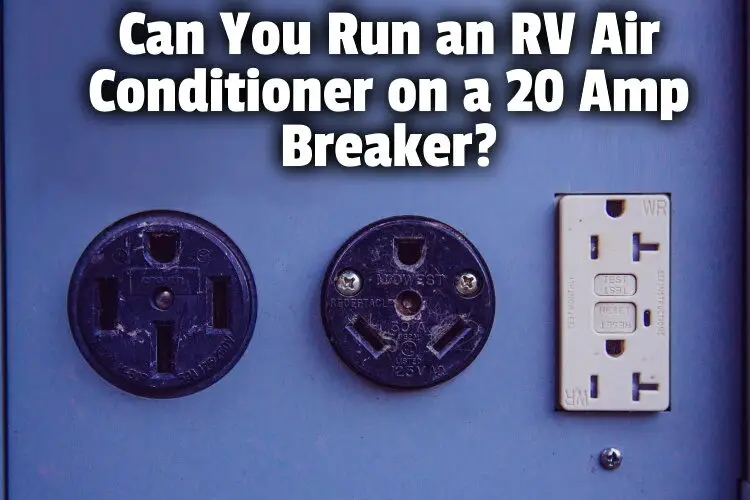
Sometimes, you may find yourself at a campground that only offers 20 amp service. This has some people wondering: can you run an RV air conditioner on a 20 amp breaker?
Here’s what I know from my RV:
A 20 amp outlet isn’t enough to power and run an RV air conditioner. RV air conditioners need a minimum of 30 amps to run, but you won’t have any power left over for anything else.
But there’s a lot more to know about running your RV air conditioner than that!
In this article, we’ll talk about how RV AC works and some solutions to keep cool when you find yourself at a campground that only has 20 amp service.
Just keep reading!
Air conditioning – do you really need it for your #caravan or #motorhome? If you’re booking a summer break, will an AC unit make things more comfortable? Will the dog like it? After 12 months and 10 countries, here are the pros & cons. https://t.co/YQXlkM6nXX pic.twitter.com/FJO2R7MDtw
— Lee Davey (@TinTent) February 12, 2020
Does the AC in an RV work at all on 110v?
Technically, 110v is not enough to power an RV air conditioner. Most RVs are designed to be connected to 50 amp or 30 amp connectors supplied by the campground.
But there are a few things you need to be aware of when using 110.
Firstly, you should be aware of how RV electricity works. Typically, homes run on AC, and vehicles run on DC type of current. Luckily, most RVs come with both DC and a system to hook up AC, such as when you are plugging into a home outlet.
To hook up an RV to a 110v outlet you will need an adapter.
Most RVs have a 50 amp connector, so you’ll need to have an adapter that goes from 50 amps to 30 amps. And then a second adapter to go from 30 amps to 110v.
All of that being said, a small AC may run on 110v provided you aren’t running much else. Then make sure to run the AC on a low setting, with the fan on auto, and don’t set the thermostat too cold.
On average, roof air conditioners pull 12-16 amps.
Then when it kicks in, it will draw up to 7 times the number of amps than it does while it’s just running. It needs to be on the lowest setting so that the A/C kicking surge doesn’t risk damage to your RV or the home.
Finally, the only thing running should be the air conditioner. Don’t run anything else in the RV while the air conditioning is running on a home outlet.
Just like camping with limited AC, camping without hookups can be difficult if you’ve never done it before.
Camping without hookups is called “boondocking” or dry camping. Typically, you can go 14 days before you need to dump your tanks, charge your batteries, or add fuel to your generator.
To read more about how long you can dry camp in an RV, just read this recent article. After all, you don’t want to be stuck in the boonies with dead batteries.
Just click the link to read it on my site.
Can you contact me about converting a 20 ft motor home to a 100% electric RV? Heat and generator are propane and gas powered. All other appliances refrigerator oven hot plate hot water heater and water pump are all electric. pic.twitter.com/E70bIo08Sy
— Gloria Marasciullo (@GMarasciullo) September 23, 2019
How many amps does an RV AC use?
A 15,000 BTU air conditioning unit draws around 12.5 amps. It can draw around 15 amps when it’s running in cool mode. It can draw up to 16 amps when set to heating mode.
If you plan on running anything else while the air conditioning is running, like a hairdryer, coffee maker, or any other electrical appliance, it’s important to know how much your air conditioning is drawing.
Knowing the amperage drawn by each appliance in your RV can help prevent the risk of tripping circuit breakers or even causing a fire. The majority of RVs are wired for either 30-amp service or 50-amp service.
On average, a 15,000 BTU air conditioning unit draws around 12.5 amps.
That can increase when the unit starts up. But it could be higher if you have more units or bigger units. And it can draw even more amperage when it’s in heating mode.
So if you are connected to a 20 amp service and planning on running your AC, you risk flipping your circuit breaker. And that’s the only thing you’ll be able to run.
Today is the reason you need this. And ours are working perfectly! #aircon #rimor #motorhome #hottestdayoftheyear pic.twitter.com/mX4VlmPgZX
— Go Explore Scotland (@GoExploreScot) July 19, 2016
What will work in an RV off a 110v 20 amp outlet?
An RV connected only to a 110v 20 amp outlet will have only enough to power the lights and refrigerator. Alternately with almost nothing else on, a small air conditioner may be able to operate.
To save some amperage, run the refrigerator and the water heater on propane.
You can count on your air conditioning to draw anywhere from 12-16 amps per unit. That’s a lot, but you might be surprised at how much amperage smaller appliances use as well.
For example, a coffee maker uses 5-8 amps, a blender uses 5-6 amps, but a slow cooker uses only 1-2 amps.
Below is a more complete list of amps that the small appliances in your RV may use. Keep in mind that many RV appliances require more amps to start the appliance than they do to keep it running.
| Appliance/Electronic Equipment | Estimated Amps |
| Air Conditioner (x number of units) | 12-16 |
| Blender | 5-6 |
| Coffee Maker | 5-8 |
| Laptop | 2-3 |
| Converter | 1-8 |
| Slow Cooker | 1-2 |
| Curling Iron | <1 |
| Drill | 2-6 |
| Electric Fan | 1 |
| Electric Skillet | 6-12 |
| Hair Dryer | 5-12 |
| Microwave | 8-13 |
| Television | 1.5-4 |
This is not an extensive list of appliances, but it gives you a pretty good idea of what you can use on the 20 amp service.
My first time glamping in an RV. I loved it especially when it rained overnight. Here are some pics inside the RV. #glamping #camping #longweekend #RV #RVlife #summer #ontario #momlife #motherhood #fun pic.twitter.com/hRhQp2bWwe
— Jee-Yun Lee (@JeeYunTV) August 3, 2020
Can I plug my 30 amp or 50 amp RV cord into a 20 amp connector?
A 30 or 50 amp connector can work with a 20 amp 110v outlet but will require adapters. Typically an RV with a 50 amp connector would need 1 adapter to reduce it to 30amps and a 2nd adapter to convert the 30 amp to 110v.
You can go years without needing an adapter, but when you need one, you need one, and there aren’t any substitutes.
A 30 amp to 50 amp cord adapter like this one from Amazon allows you to convert shore power to 50 amps. At 50 amps, you can power everything you need. You can run your air conditioning, microwave, TV, and other small appliances without any problem.
It also has handles built right onto both ends of the adapter. This makes unplugging it that much easier! No fighting and trying to find just the right grip to unplug from the receptacle.
It’s inexpensive, and it comes with a two-year warranty, so it is well worth the money even if it is one of those things you won’t use very often.
A 15 amp to 30 amp adapter like this one from Amazon is rated for 125 volts. This is a great option to connect a 30 amp RV to a 20 amp circuit. It’s durable and gets excellent reviews on Amazon.
If you’ve connected everything properly and find that your outlets aren’t working, it may not necessarily be the amperage coming into your RV.
The most common causes of RV outlets not working are tripped GFCI outlets or the power inverter being off when not connected to shore or generator power.
To learn more about why your RV outlets may not be working, check out this recent article. I get into all the troubleshooting steps and tricks including the 1 thing almost every RV’er misses when they first head out in their RV.
Just click the link to read it on my site.
There has been some debate on the best way to distribute heat inside of an RV, and we’d like to set the record straight, literally.https://t.co/3fjMxdFxZ6 pic.twitter.com/IQzBQIDzb6
— Keystone RV (@KeystoneRVCo) December 4, 2020
Can I run my RV air conditioner on battery power?
Most RVs won’t be able to run an air conditioner off battery power. While many RVs have more than 1 battery, it is not typically enough to operate an air conditioning unit. And many RVs have 2 or more AC units.
Air conditioning requires a lot of electricity just to get started and then to keep it running for just an hour.
Most newer RVs come equipped with a 15,000 BTU air conditioning unit. They need a minimum of 3,500 watts to get started and about 1,500 watts to keep it running.
Not all RVs don’t come with an inverter. And, the ones that do come with an inverter come with one that ranges from 1,000 watts to 2,000 watts.
This simply isn’t enough juice to convert your battery power to usable AC electricity. You’ll need at least a 4,000 watt DC to AC power inverter.
Higher-end RVs come equipped with power inverters, but they also come with two or even three air conditioning units. This means you’ll need a power inverter as high as 7,000 watts to start and run the air conditioning.
It is possible to run your air conditioning off of battery power like this. You’ll need three 100 amp-hour Lithium Ion-Phosphate batteries, about 1,500 watts of solar panels, and a 7,000-watt power inverter.
This will run two 15,000 BTU air conditioning units for about an hour. That’s a lot of weight, and expense, for an hour of cool air.
If you’re running your AC off of your generator, you can run it for as long as you have fuel in your tank. Since generators use very little fuel, you can run it all night without issue.
To read more about how long you can run your air conditioner off of your generator, check out this recent article. While they don’t use a lot of gas to run all night, is there a risk of carbon monoxide?
Just click the link to read it on my site.
Did I answer everything you wanted to know about whether you can run your RV AC on a 20 amp breaker?
You can run your air conditioning on a 20 amp breaker, but you won’t be able to use anything else in the RV.
Suppose you really want to run your RV air conditioner on battery power. In that case, it’s going to require an extensive setup with Lithium-Ion Phosphate batteries, solar panels, and a power inverter.
Your best bet to avoid problems at a campground with a 20 amp service is to purchase an adapter. They’re cheap, don’t take up a lot of space, and you’ll have them when you need them.
Photo which requires attribution:
Campground Electric Hookups – RV 50 Amp, 30 Amp, and 15 / 20 amp by Tony Webster is licensed under CC2.0
